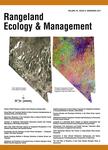版权所有:内蒙古大学图书馆 技术提供:维普资讯• 智图
内蒙古自治区呼和浩特市赛罕区大学西街235号 邮编: 010021

作者机构:Rocky Mt Off Environm Def Fund Boulder CO 80304 USA
出 版 物:《RANGELAND ECOLOGY & MANAGEMENT》 (牧场生态与管理)
年 卷 期:2009年第62卷第4期
页 面:351-355页
核心收录:
学科分类:0830[工学-环境科学与工程(可授工学、理学、农学学位)] 0905[农学-畜牧学] 09[农学] 0713[理学-生态学]
主 题:ecosystem heterogeneity grassland birds grazing management grazing systems land management policy livestock distribution rangeland policy wildlife management
摘 要:Wildlife conservationists and agencies have recommended managing rangelands for vegetation heterogeneity to improve wildlife habitat, particularly for many grassland birds. However, range management focuses on livestock production and associated practices and structural items (fences, water developments) that are applied to improve livestock distribution. This article assesses the occurrence of livestock distribution-oriented grazing management in the spending and applied practices of the Natural Resources Conservation Service (NRCS), the federal agency charged with assisting private landowners with implementation of US Department of Agriculture conservation programs. NRCS applied practices and spending both suggest all emphasis on livestock distribution and associated structures, with almost 20 million ha of prescribed grazing systems, 10000 km of fence, and 127000 water facilities implemented in 17 western states with assistance from NRCS programs between 2004 and 2007. Ninety percent of funding for 2005 Conservation Security Program grazing enhancements supported investments or management related to livestock distribution. We suggest that increasing the emphasis of NRCS conservation programs and financial assistance on maintaining or increasing compositional and structural heterogeneity of vegetation, rather than on livestock distribution, could be an approach that unifies livestock production and wildlife habitat objectives. In particular, including vegetation heterogeneity as a central goal for upland wildlife habitat management could be a key opportunity to increase incentives for heterogeneity-promoting management on privately owned rangeland.